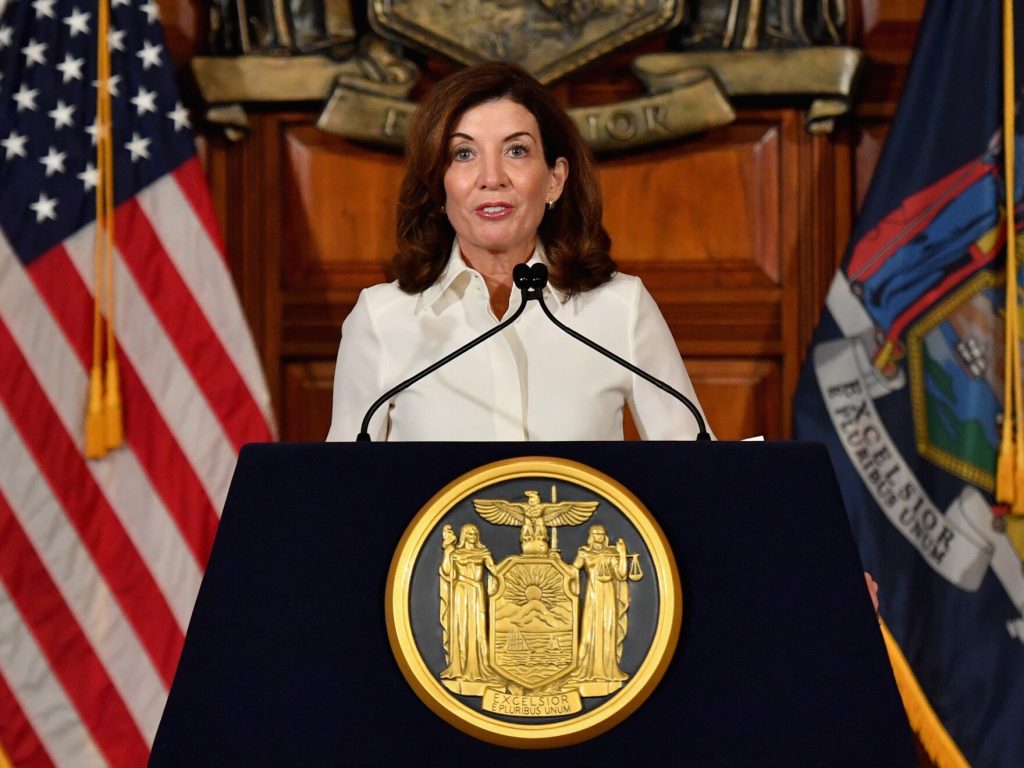Governor Kathy Hochul remains steadfast in her push to reform the distribution of state school aid, a move that has ignited a storm of opposition from various quarters, including Democrats, Republicans, unions, and school districts.
Doubling Down on School Aid Overhaul
While making an economic development announcement in Syracuse, Governor Hochul not only reiterated her commitment to revamping the state’s school aid system but also called out school districts sitting on surplus funds. She emphasized the need for responsible use of surplus funds, suggesting that the money should either be invested in schools, allocated to teachers for resources, or returned to taxpayers.
Governor Hochul originally unveiled her proposed changes to the foundation aid formula in January as part of the 2025 executive budget. Her office identified two key areas for reform, primarily focusing on addressing declines in population and updating outdated formulas.

Read more:
- Diversity Prohibition in Texas Public Colleges: Effects on Students and Multicultural Organizations
- High School Athletes in Florida May Soon Benefit from NIL Opportunities
- Student Consequences Authorized for Supporting Hamas
- Student Loan Realities: The Shift from Pause to Panic for Borrowers
Foundation Aid Formula Changes
The governor highlighted concerns regarding school districts experiencing a 25% to 30% decline in population while still being tethered to formulas based on 2008 population data. One significant proposal aims to eliminate the “hold harmless” provision in the foundation aid formula, a safeguard preventing districts from receiving less aid than the previous year. Hochul suggests replacing this provision with a “transition adjustment,” protecting districts from 50% to 91% loss of aid.
Another notable change in the proposal is expanding the foundation aid formula’s consideration of inflation. The current formula relies on the previous year’s inflation data, whereas Hochul advocates for a shift to a 10-year average.
Wide-ranging Opposition
Despite the governor’s persistence, a growing chorus of opposition is gaining momentum. Numerous unions, advocacy groups, and lawmakers have voiced their disapproval of the proposed changes, labeling them as disingenuous, political, and unnecessary.
David Little, Executive Director of the Rural Schools Association of New York State, criticized the changes, expressing concerns that the alterations could force local governments to raise taxes to compensate for lost revenues. He emphasized that the proposed changes could potentially lead to the dismantling of recently instituted school programs.
The New York State United Teachers (NYSUT), the largest teachers union in the state, joined the opposition, condemning the proposals as cuts rather than reforms. Melinda Person, NYSUT President, expressed disappointment, asserting that the state is turning its back on its commitment to supporting students and communities.
Both RSANY and NYSUT criticized the changes to the formula as arbitrary, signaling a definitive shift in Governor Hochul’s approach to the education system. Little pointed out that 70% of the affected funding comes from average and high-need school districts, portraying the proposed changes as disproportionately impacting economically disadvantaged areas.
Potential Impact on School Districts
Data provided by NYSUT revealed that North Tonawanda City Schools could face the most substantial decrease in aid, losing $1,999,214 if the governor’s plan passes the legislature. Meanwhile, the West Valley Central School District could witness the largest percentage reduction, with a 19.4% decrease, equivalent to $711,613.
Governor Hochul’s office acknowledged that 337 districts across the state would receive less funding in the 2024-2025 fiscal year compared to the previous year if the plan moves forward. In contrast, 336 districts would experience an increase in state aid. Notably, no Western New York school district, according to NYSUT’s data, would see an increase in aid under the governor’s proposal.
Conclusion: The Battle for Educational Funding Continues
As Governor Hochul stands firm in her commitment to reshape the school aid landscape, the battle lines are drawn, with opposition intensifying from diverse groups. The fate of the proposed changes rests on legislative decisions, and the coming weeks are poised to be crucial in determining the trajectory of educational funding in the state. The clash between the governor’s vision for reform and the concerns raised by unions, advocacy groups, and school districts underscores the complexity of the issue and the challenges inherent in achieving consensus on such a critical aspect of public policy.



